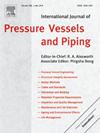Investigation of crack propagation and mechanical field evolution at the tip of a growing crack under variable loading in dissimilar metal welded joints
IF 3
2区 工程技术
Q2 ENGINEERING, MECHANICAL
International Journal of Pressure Vessels and Piping
Pub Date : 2025-03-04
DOI:10.1016/j.ijpvp.2025.105496
引用次数: 0
Abstract
This study investigates crack propagation paths at different locations in a dissimilar metal welded joint (DMWJ) within a nuclear power plant (NPP) and examines the distribution of mechanical fields at the tip of the growing crack under various loading conditions. First, the microstructure and mechanical properties of the DMWJ are thoroughly analyzed. Next, the field subroutine “USDFLD” is used to establish a correlation between the non-uniformly distributed material mechanical properties and their spatial positions, thus characterizing the mechanical heterogeneity within the welded joint. Building upon this, a crack growth criterion based on the crack tip opening stress (CTOS) is developed using XFEM in conjunction with the UDMGINI subroutine. The influence of mechanical heterogeneity on stress corrosion cracking (SCC) propagation paths are then investigated. Finally, utilizing the identified crack propagation paths, the mechanical fields at the tip of the growing crack are analyzed under different loading conditions. The results indicate significant differences in the microstructure of local regions of the DMWJ, leading to an uneven distribution of local mechanical properties. Chemical composition gradients exist in the interface region, and significant fluctuations in mechanical properties are often observed near the interface. The material on the higher yield strength side has lower plastic constraints and crack resistance, which tends to result in a higher crack tip driving force. SCC cracks usually propagate towards the higher yield strength side, and the higher the yield strength, the longer the crack propagation length. Crack propagation induces the unloading process at the crack tip. As the crack extends, residual stresses or residual plastic strains are released and redistributed at the crack tip. A single tensile overload can relax the stress near the crack tip within a certain distance, reducing the strain rate.
变载荷作用下异种金属焊接接头裂纹扩展及裂纹尖端力学场演化研究
本文研究了核电厂内异种金属焊接接头(DMWJ)在不同位置的裂纹扩展路径,并研究了不同载荷条件下裂纹扩展尖端的力学场分布。首先,对DMWJ的微观结构和力学性能进行了深入分析。其次,利用场子程序“USDFLD”建立非均匀分布的材料力学性能与其空间位置之间的相关性,从而表征焊接接头内部的力学非均匀性。在此基础上,结合UDMGINI子程序,利用XFEM建立了基于裂纹尖端开启应力(CTOS)的裂纹扩展准则。研究了力学非均质性对应力腐蚀裂纹扩展路径的影响。最后,利用识别的裂纹扩展路径,分析了不同加载条件下裂纹扩展尖端的力学场。结果表明,DMWJ局部组织存在显著差异,导致局部力学性能分布不均匀。界面区域存在化学成分梯度,界面附近经常观察到明显的力学性能波动。高屈服强度侧的材料具有较低的塑性约束和抗裂性,这往往导致较高的裂纹尖端驱动力。SCC裂纹通常向屈服强度高的一侧扩展,且屈服强度越高,裂纹扩展长度越长。裂纹扩展诱发了裂纹尖端的卸载过程。随着裂纹的扩展,残余应力或残余塑性应变在裂纹尖端被释放并重新分布。单次拉伸过载可以在一定距离内使裂纹尖端附近的应力松弛,从而降低应变率。
本文章由计算机程序翻译,如有差异,请以英文原文为准。
求助全文
约1分钟内获得全文
求助全文
来源期刊
CiteScore
5.30
自引率
13.30%
发文量
208
审稿时长
17 months
期刊介绍:
Pressure vessel engineering technology is of importance in many branches of industry. This journal publishes the latest research results and related information on all its associated aspects, with particular emphasis on the structural integrity assessment, maintenance and life extension of pressurised process engineering plants.
The anticipated coverage of the International Journal of Pressure Vessels and Piping ranges from simple mass-produced pressure vessels to large custom-built vessels and tanks. Pressure vessels technology is a developing field, and contributions on the following topics will therefore be welcome:
• Pressure vessel engineering
• Structural integrity assessment
• Design methods
• Codes and standards
• Fabrication and welding
• Materials properties requirements
• Inspection and quality management
• Maintenance and life extension
• Ageing and environmental effects
• Life management
Of particular importance are papers covering aspects of significant practical application which could lead to major improvements in economy, reliability and useful life. While most accepted papers represent the results of original applied research, critical reviews of topical interest by world-leading experts will also appear from time to time.
International Journal of Pressure Vessels and Piping is indispensable reading for engineering professionals involved in the energy, petrochemicals, process plant, transport, aerospace and related industries; for manufacturers of pressure vessels and ancillary equipment; and for academics pursuing research in these areas.

 求助内容:
求助内容: 应助结果提醒方式:
应助结果提醒方式:


